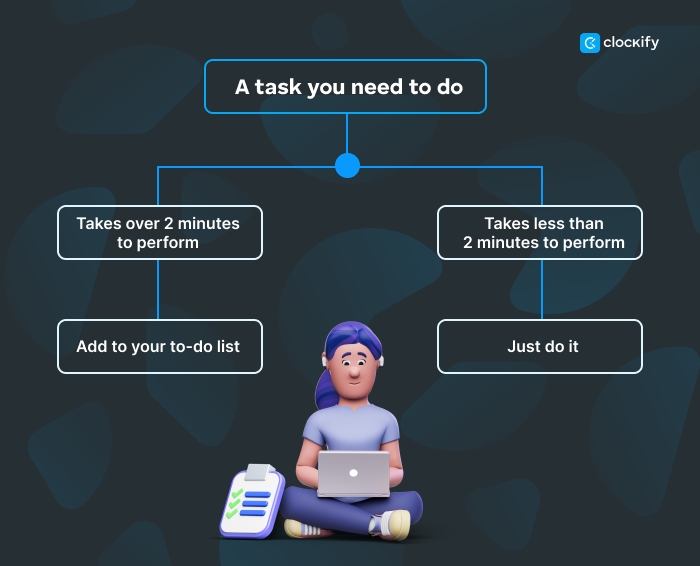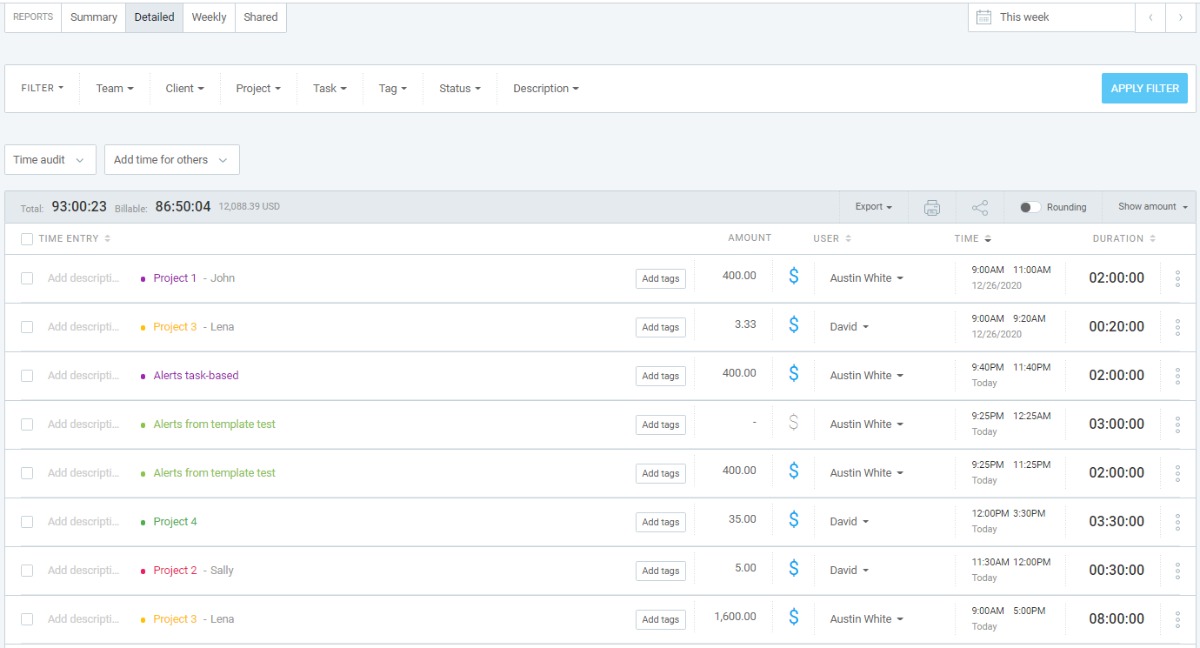Have you ever finished a short task you dreaded and thought — Why didn’t I do this sooner?
If you don’t reply to an email right away because you think you’ll have more time or tact later, chances are you’ll postpone it for at least a few hours, if not days.
Not only is this unprofessional, but the number of times this specific email will cross your mind and affect your attention is ridiculous.
That’s why we want to introduce you to the 2-minute rule.

What is the 2-minute rule and why is it important?
Coined by David Allen in his book Getting Things Done and later widely used by productivity experts, the 2-minute rule has stood the test of time.
According to the author, when a task arises and takes 2 minutes or less to complete, you should do it immediately.
The rule is flexible — you can apply it to tasks that take 1, 5, or even 10 minutes.
Anyway, the point is to start. This creates momentum that keeps you going, allowing you to finish all the tasks on your to-do list.
Most importantly, it frees you from the mental burden that comes with avoiding tasks.
CEO and digital strategist Solomon Wiesen says the 2-minute rule acts like a psychological trick that enables you to start working on tasks instead of remaining still:

“Procrastination feeds off inertia, and the 2-minute rule acts like a jolt of energy, forcing you to take that first step. It’s like tricking your brain into saying, ‘Okay, I’ll just start with this little thing,’ and before you know it, you’re in the flow and tackling the bigger stuff too.”
💡 CLOCKIFY PRO TIP
If you’re interested in learning more about procrastination, read the following article:

2 ways to use the 2-minute rule
Let’s see how to stop procrastinating by using the 2-minute rule.
Tackle quick tasks
In a single workday, we complete dozens of simple and quick tasks. Whether it’s starting a timer for tracking time, replying to an email, or scheduling a meeting, these actions can be done in a matter of seconds.
So why is it a problem if we don’t do them straight away?
Because small tasks tend to accumulate even faster than big ones. In fact, they create a mental burden and prevent us from focusing on what’s important.
The 2-minute rule helps prevent procrastination before it starts. If a task arises and is connected to what you’re currently doing, you should do it right away.
For example, if you’re clearing out your inbox and you come across an email that only requires a quick response or deletion, handle it immediately.
Business owner Austin Cohen reveals that the greatest benefit of using the 2-minute rule is helping us complete all the tasks from our to-do lists:

“The biggest advantage of the 2-minute rule is its ability to transform daunting to-do lists into manageable actions, which leads to greater productivity.”
However, beware of handling only short tasks, as they can quickly take up much of your productive time.
Business owner George Yang let us in on a useful method to prevent anyone from doing only short tasks — it boils down to combining 2-minute tasks with blocks of uninterrupted work:

“One of the possible cons is an overemphasis on minor tasks at the expense of more strategic work. This is countered by balancing the various 2-minute tasks well within the blocks of time dedicated to work that is more critical, deep, and focused.”
💡 CLOCKIFY PRO TIP
The best way to make uninterrupted work happen is to block time slots and dive into deep work. Learn more about how to do it and what are the benefits in the following blog posts:
Tackle big tasks
Short tasks make up only a small part of our workday. Most of our time is spent on large, meaningful tasks that take hours to finish.
But, you know what they say — A journey of a thousand miles begins with a single step.
When you break down a large task into smaller components, you’ll see that even issuing invoices to clients starts with a simple click on the “Create Invoices” option.
Or, maybe you need to conduct 1:1 meetings with all your employees to give them feedback on their performance.
Let’s say you’re managing a team of 10. First, you’ll want to check their availability in the schedule. Then, you proceed with booking meetings for each employee.
Before each meeting, gather notes on the performance of that particular person. Add additional speaking points you think would be useful.
Turn off the volume on your phone. If you’re having an online meeting, check whether your camera and microphone work. Have a fresh glass of water or coffee next to you.
After a series of small, practical steps taken for preparation, the meeting can start.
You see, once you set your goals and break them into manageable chunks, all you’ve got to do is repeat the process every day, until the habit is formed.
Specifically, according to a study about habit formation, published in the European Journal of Social Psychology, it can take between 18 and 254 days to create a habit.
💡 CLOCKIFY PRO TIP
Eliminating bad habits is just as important as creating new ones. Read on to learn how time tracking can help with this:
Examples of 2-minute tasks at work
Here’s a list of tasks you can tackle when starting to implement the 2-minute rule into your work routine:
- Make your favorite beverage,
- Start tracking time,
- Reply to an e-mail,
- Water the plant on your desk,
- Tidy up your desk,
- Consult with a colleague,
- Make a to-do list,
- Delete non-important emails from your inbox, and
- Create invoices for your clients.
You can easily add more tasks to this list depending on the type of work you do.
💡 CLOCKIFY PRO TIP
The 2-minute rule is super useful when decluttering your office space. In the following article, learn how to declutter your digital space efficiently:
How to use the 2-minute rule effectively to beat procrastination?
Here are some useful tips to beat procrastination once and for all.
Tip #1: Strive for action, not perfection
Striving for perfection is a major cause of procrastination. Instead of spending endless time thinking about how to finish something — just start.
Doing high-quality work is the main goal, but it shouldn’t overwhelm you. One study about perfection found that it’s been linked to anxiety and general distress.
To reduce anxiety and desire for perfection, remember that it’s always better to take action rather than wait.
Tip #2: Stay consistent to get the finest results
If you decide to implement the 2-minute rule into your work routine, it’s vital to do it consistently. Only then will you see the best results.
Each morning, decide which tasks fall under this category and commit to finishing them every single day.
💡 CLOCKIFY PRO TIP
Knowing the difference between important tasks and those that aren’t can put you ahead of the competition. Learn how to use the Eisenhower matrix for better time management:
Tip #3: Work on smaller tasks when you need a mental break
Engaging in meaningful tasks for hours can leave you exhausted. This is when you should take a mental break by switching to tasks that don’t require 100% of focus.
That way, you’ll still be productive while giving your brain a refreshing break from more demanding work.
Trial attorney and business owner Andrew Pickett advises business owners to pay attention to small wins as they also lead to advancement:

“My top recommendation for effectively implementing this rule in a professional environment is to encourage a cultural shift that celebrates small victories and reinforces the idea that even minimal efforts contribute to progress.”
💡 CLOCKIFY PRO TIP
The 2-minute rule is super useful when decluttering your office space. In the following article, learn how to declutter your digital space efficiently:
Cons of the 2-minute rule
Let’s take a closer look at the possible disadvantages of this unique rule.
Con #1: Focusing too much on smaller tasks can distract you from deep work
After spending an entire day on minor tasks, you may realize you haven’t been all that productive.
While you may have done tasks that are easy and quick to do, the tasks that cause your procrastination are still unfinished.
💡 CLOCKIFY PRO TIP
But, before you decide to combine different types of tasks, learn how to set SMART goals and enhance your productivity at work:
Con #2: The 2-minute rule doesn’t work for all types of tasks
Finishing short tasks and starting a momentum for productivity are core features of the 2-minute rule. However, once you pass the 2-minute threshold and enter the zone of deep work, it ceases to be useful.
Uninterrupted focus is much more significant than your task list. This is when new ideas are born and when you make decisions and take actions that will propel your business to new heights.
One company researched top distractions at work, and the results show that employees lose 6.33 hours a week due to distractions.
💡 CLOCKIFY PRO TIP
While we all know that focus is important, knowing specific ways to increase it is much more useful. Read some of our blogs on focus and distractions at work:
Use Clockify and the 2-minute rule for the best results
Knowing how much time you’ll spend on a certain task is the foundation of a successful organization.
Whether it’s 2 minutes or 20 hours, tracking time spent on projects can enhance business performance and reduce stress.
All you need now is Clockify — an easy-to-use time tracking tool with many different ways to track time:
- Set a timer — start the timer at the beginning of your shift and stop it when you’re done,
- Enter time manually — if you’ve already completed a task but want to log the time, simply enter it manually, and
- Auto-track time — record the time spent across different apps or projects, and create time entries later.

And the best part about Clockify is that you can use it not only for time tracking but also for:
- Scheduling,
- Vacation planning, and
- Reporting.
It’s an all-in-one solution that will take your company’s productivity to the next level.
Say goodbye to procrastination.


